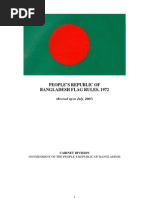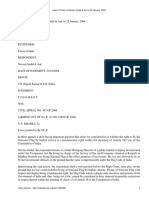The National Flag: Rules and Regulations Regarding Display of National Flag
The National Flag: Rules and Regulations Regarding Display of National Flag
Uploaded by
Aditya SinghCopyright:
Available Formats
The National Flag: Rules and Regulations Regarding Display of National Flag
The National Flag: Rules and Regulations Regarding Display of National Flag
Uploaded by
Aditya SinghOriginal Description:
Original Title
Copyright
Available Formats
Share this document
Did you find this document useful?
Is this content inappropriate?
Copyright:
Available Formats
The National Flag: Rules and Regulations Regarding Display of National Flag
The National Flag: Rules and Regulations Regarding Display of National Flag
Uploaded by
Aditya SinghCopyright:
Available Formats
THE NATIONAL FLAG
The flag of a nation is the symbol of a nation at all places whether it is an event, meeting or any
activity. Throughout the whole world different nations have distinct National flags. Our country
India also has a distinct national flag. If we give the description of our national flag, then it is a
horizontal tricolored flag comprising of India saffron ,white and India green, with the Ashoka
Chakra 24 spokes Wheel navy blue at its centre.
Saffron colour remains at the top, white portion is in the middle with the Ashoka Chakra
consisting of 24 spokes wheel and at the bottom remains the green portion of the flag. Different
portions of our national flag have many hidden meanings like Saffron colour in our flag
symbolises mental strength, which plays a vital role in everyone's life. White portion of the flag
depicts peace and truth. Green person stands for creative fertility and growth at our workplace.
Dharma Chakra consisting of 24 spokes have different meanings which plays an important role
for being a good human being and a patriotic citizen of our country.
If we go back to the adoption of our national flag, the flag which we used nowadays was
designed by Pingali venkayya a freedom fighter and follower of Mahatma Gandhi. Our Indian
tricolour national flag was adopted by the constituent assembly on 22nd of July 1947.
On the occasion of Independence Day, national flag is tied at the bottom and then pulled up by
the prime minister of our country and this activity takes place at the Red Fort. On the occasion
of Republic Day the flag is tied up on the top and it is unfurled without pulling it up. This activity
depicts that our country runs on our own principles rather than being a puppet. On the
occasion of Republic Day our national flag is unfurled at the Rajpath by the president of India.
Rules and regulations regarding display of national flag.
Our national flag Unites the nation and maintain unity in diversity. It’s a symbol of pride to our
country. So to avoid disrespect to it by our citizens or Institutions, there are certain guidelines
that are mentioned in the flag code of India 2002.
Our national flag can be depicted by any general public private organisation and educational
institutions at any place throughout the whole country. We cannot use the National Flag for the
purpose of trade, business or in a patent or Trademark purposes except in conditions
prescribed by the central government. Keeping in mind “The prevention of insults to the
national honours Act” 1971. We cannot dip the flag to give salute to any person or thing.
According to the aforementioned act, any person in public place or within public view burns,
mutilates, defaces, defiles, disfigures, destroys, tramples upon or otherwise brings into
contempt the Indian National flag shall be punished with imprisonment for a term which may
extend to three years or fine or both. We cannot use the flag as drapery. The flag cannot be
used in costumes and neither it should be embroidered on any object. Writing anything on the
flag is highly prohibited. Flags cannot be used as carrying bag or for carrying anything except
flowers which is kept inside it while unfurling it. The flag should not touch the ground neither it
should be draped over a vehicle train or aircraft nor it should be used for covering building.
Whenever the flag is hoisted vertically, the saffron portion will always remain at the top.
Damaged flag or when the flag is in soiled condition, it should not be hoisted. When the flag is
in a damaged condition or Soiled condition it shall be destroyed at home in private preferably
by burning or by any other method consistent with the dignity of the flag.
After knowing all these aspects, we come to know that we should give utmost respect to our
national flag. Our national flag shows us our culture, unity in diversity. It is pride to our country.
We should never let it down. Our country has given us so much, such a peaceful environment
to live, such a beautiful amalgamation of sceneries that when we see it, every pain of ours goes
away, everything so will administer, providing us everything that is required for a well and
healthy living. In the same way, we should never do anything that lowers down the dignity of
our country. We should always give respect to our national flag which is an important facet to
the dignity of our country. We must follow the guidelines given under the aforementioned act
and codes to correctly display the national flag.
You might also like
- STep Up1 LibricettoDocument41 pagesSTep Up1 LibricettoRomina100% (5)
- Essay of National FlagDocument1 pageEssay of National Flager_ppravin100% (1)
- Republic Day 2012 Prayer Service 26 Jan 12-11-12Document9 pagesRepublic Day 2012 Prayer Service 26 Jan 12-11-12Lowe Glenford67% (6)
- Flag Code of IndiaDocument4 pagesFlag Code of IndiaMahendra Kumar MalviyaNo ratings yet
- DO - Ministry of Home - AffairsDocument9 pagesDO - Ministry of Home - Affairssiva kishoreNo ratings yet
- HarghartirangaDocument9 pagesHarghartirangaRavi kumar MishraNo ratings yet
- Faq 18072023Document6 pagesFaq 18072023Yogesh Gowda Mj YogiNo ratings yet
- Essay On FlagDocument1 pageEssay On FlagAnonymous Y1eiYIykMKNo ratings yet
- Flag Code in IndiaDocument32 pagesFlag Code in Indiasatyanarayan kNo ratings yet
- Republic Day SpeechDocument2 pagesRepublic Day SpeechclavakapNo ratings yet
- Good Morning To One and AllDocument2 pagesGood Morning To One and AllclavakapNo ratings yet
- Ii. Civics: Unit - IDocument12 pagesIi. Civics: Unit - IvijayagarwalindNo ratings yet
- National FlagDocument2 pagesNational FlagzameerNo ratings yet
- National SymbolsDocument63 pagesNational SymbolsPolisetty GupthaNo ratings yet
- Indian FlagDocument5 pagesIndian Flagmanasvivaid0304No ratings yet
- Flag Code of India, 2002Document25 pagesFlag Code of India, 2002Diana AloysNo ratings yet
- Bangladesh National Flag RulesDocument7 pagesBangladesh National Flag RulesbabujunkNo ratings yet
- Main Points - Flag Code - GujaratiDocument2 pagesMain Points - Flag Code - Gujaratirax109No ratings yet
- Flag Code of India: Flag Size No. Dimensions in MMDocument4 pagesFlag Code of India: Flag Size No. Dimensions in MMRaja_343No ratings yet
- Flag Facts For USDocument4 pagesFlag Facts For USMona LisaNo ratings yet
- Republic Day Is Not Just A National Holiday For IndiansDocument4 pagesRepublic Day Is Not Just A National Holiday For IndiansShantu ShirurmathNo ratings yet
- Union of India Vs Naveen Jindal & Anr On 23 January, 2004Document20 pagesUnion of India Vs Naveen Jindal & Anr On 23 January, 2004pshubham65_5517202270% (1)
- Indian Independence Day PDFDocument2 pagesIndian Independence Day PDFshezan.bhuiyan100% (1)
- Para 1Document1 pagePara 1bolmonacomeNo ratings yet
- History and Background of Indian National FlagDocument7 pagesHistory and Background of Indian National FlagNaman MishraNo ratings yet
- Corimo Assign #4Document1 pageCorimo Assign #4graceNo ratings yet
- Indian FlagDocument4 pagesIndian FlagVijay PatilNo ratings yet
- National Flag - The True Symbol of NationalDocument24 pagesNational Flag - The True Symbol of NationalDrishti MalhotraNo ratings yet
- Fundamental Duties Shankar (1)Document8 pagesFundamental Duties Shankar (1)shivanadgdNo ratings yet
- 1.2. National SymbolsDocument54 pages1.2. National SymbolsJAFARI APILANo ratings yet
- Har Ghar Tiranga ANN - 10 - 08 - 2023Document9 pagesHar Ghar Tiranga ANN - 10 - 08 - 2023ankitasingh79037No ratings yet
- Flag InformationDocument4 pagesFlag InformationWICKPHAL ENTERPRISENo ratings yet
- National AnthemDocument2 pagesNational Anthemrohan09No ratings yet
- National SymbolsDocument8 pagesNational Symbolsprakash jhaNo ratings yet
- WWW Jagranjosh Com General Knowledge Republic Day National Flag of India History Journey and Facts 1579949419 1 Ref List GKDocument7 pagesWWW Jagranjosh Com General Knowledge Republic Day National Flag of India History Journey and Facts 1579949419 1 Ref List GKshukla dhavalNo ratings yet
- Fundamental Duties: By: Sahil PasrijaDocument21 pagesFundamental Duties: By: Sahil PasrijaAbhishek MishraNo ratings yet
- Civic Education Year 10 National ConsciousnessDocument13 pagesCivic Education Year 10 National ConsciousnessIyebiyelojuoluwa OmotoshoNo ratings yet
- SpeechDocument3 pagesSpeechsunny bhaiNo ratings yet
- AnchorDocument3 pagesAnchorArshNo ratings yet
- August 15 Independence Day in IndiaDocument10 pagesAugust 15 Independence Day in IndiaIndezine100% (1)
- TypingDocument1 pageTypingshamagondalNo ratings yet
- Indipendence Day SpeechDocument3 pagesIndipendence Day Speechpradeepsatpathy100% (1)
- India Flag Is Not Only of Freedom For We PeoplesDocument13 pagesIndia Flag Is Not Only of Freedom For We Peoplesswapnil017No ratings yet
- Indian Flag: The Amendment To The Flag Code in India. 2002Document2 pagesIndian Flag: The Amendment To The Flag Code in India. 2002MeeNu KarthikNo ratings yet
- Response Paper - FJIDocument4 pagesResponse Paper - FJIYouTube PremiumNo ratings yet
- The Evolution of Indian National FlagDocument3 pagesThe Evolution of Indian National FlagKhushi TyagiNo ratings yet
- Nigerian Culture DocumentDocument17 pagesNigerian Culture DocumentMary Jardine0% (1)
- 15 August SpeechDocument2 pages15 August SpeechgurusodhiiNo ratings yet
- Flag Code NSTPDocument7 pagesFlag Code NSTPKaye Ann JavierNo ratings yet
- REPUBLIC DAY SPEECHDocument2 pagesREPUBLIC DAY SPEECHSudha NehraNo ratings yet
- Reverence For The Philippine FlagDocument5 pagesReverence For The Philippine FlagCoralie BaniquedNo ratings yet
- 1688990019EBook FFI4Document11 pages1688990019EBook FFI4nbn8785No ratings yet
- Flag Heraldic CodeDocument15 pagesFlag Heraldic Codeangelgrace.tiempoNo ratings yet
- The Flag CodeDocument23 pagesThe Flag Codeleslie annNo ratings yet
- RamboDocument11 pagesRamboRahul BhavanasiNo ratings yet
- Document 5Document4 pagesDocument 5Randelo EstilloreNo ratings yet
- Kanha BhaiDocument2 pagesKanha BhaiAnshuman mohantyNo ratings yet
- The Prohibited Acts On The National Flag FinallDocument4 pagesThe Prohibited Acts On The National Flag Finallpurple soyaNo ratings yet
- National Flag: We Must Always Treat Our National Flag With Respect and DignityDocument1 pageNational Flag: We Must Always Treat Our National Flag With Respect and DignityJoydip SenguptaNo ratings yet
- 0258192a28625-Mock CLAT 17 QuestionsDocument36 pages0258192a28625-Mock CLAT 17 QuestionsAditya SinghNo ratings yet
- Allocated Student CoordinatorsDocument50 pagesAllocated Student CoordinatorsAditya SinghNo ratings yet
- 0258b6e74fb50-Mock CLAT 19 QuestionsDocument36 pages0258b6e74fb50-Mock CLAT 19 QuestionsAditya SinghNo ratings yet
- All India Open Mock Test Centers Details 1Document4 pagesAll India Open Mock Test Centers Details 1Aditya SinghNo ratings yet
- Freedom of ProfessionDocument2 pagesFreedom of ProfessionAditya SinghNo ratings yet
- 信号旗的含义Document8 pages信号旗的含义zhaonanNo ratings yet
- Hotmails AccesDocument6 pagesHotmails Acceschipero2009No ratings yet
- NSTP Part 2Document3 pagesNSTP Part 2Andrea AngelicaNo ratings yet
- National Symbols NotesDocument6 pagesNational Symbols NotesignatiousmugovaNo ratings yet
- National Symbols in GuyanaDocument6 pagesNational Symbols in GuyanaJanae GarrawayNo ratings yet
- Flag & Songs: Prayer SongDocument3 pagesFlag & Songs: Prayer SongtonyNo ratings yet
- Crunch RoollDocument6 pagesCrunch Roollkunalvarad524No ratings yet
- History and MeaningDocument7 pagesHistory and MeaningJordan MosesNo ratings yet
- The Flags of Porco RossoDocument23 pagesThe Flags of Porco RossoJuan ArteroNo ratings yet
- Geography and Flags ElcDocument5 pagesGeography and Flags Elcapi-638297162No ratings yet
- Our National SymbolsDocument3 pagesOur National SymbolsshahruchiNo ratings yet
- Year 1 p1 2018 (By Miss Ash)Document7 pagesYear 1 p1 2018 (By Miss Ash)Cikgu Linda SktbNo ratings yet
- The Philippine Flag and It's Heraldic CodeDocument29 pagesThe Philippine Flag and It's Heraldic CodeAngelica CardañoNo ratings yet
- Rising Sun Flag PDFDocument4 pagesRising Sun Flag PDFdzimmer6No ratings yet
- Rich Text Editor FileDocument1 pageRich Text Editor FileEric BolsmannNo ratings yet
- Cord-Cutter net+Xtream+Codes+M3u+PlaylistDocument98 pagesCord-Cutter net+Xtream+Codes+M3u+PlaylistDzenan ImamovicNo ratings yet
- NSTP Module 1 Heraldic Code of The Philippines: Republic Act 8491 Section 1Document2 pagesNSTP Module 1 Heraldic Code of The Philippines: Republic Act 8491 Section 1Love Jovellanos Ü100% (1)
- Republic Act NO. 8491Document52 pagesRepublic Act NO. 8491rOaN D. nEpNo ratings yet
- National Flag of India: Why in NewsDocument3 pagesNational Flag of India: Why in NewsSaurabh YadavNo ratings yet
- Flag of Malawi - Wikipedia, The Free EncyclopediaDocument3 pagesFlag of Malawi - Wikipedia, The Free EncyclopediaAlison_VicarNo ratings yet
- 8 B 62 e 9536 D 32Document3 pages8 B 62 e 9536 D 32isitanshu01No ratings yet
- B - History and Meaning of The Union JackDocument2 pagesB - History and Meaning of The Union JackKreizi BlaekNo ratings yet
- Hino - Nacional - Brasileiro-Sax AltoDocument1 pageHino - Nacional - Brasileiro-Sax AltoMaicon Novaes de Sá100% (1)
- National Symbols of Republic of MoldovaDocument1 pageNational Symbols of Republic of MoldovaSanda ȘerșunNo ratings yet
- (A) 11. (A) Pride 12. (A)Document1 page(A) 11. (A) Pride 12. (A)Sandro BoremNo ratings yet
- The British FlagDocument17 pagesThe British FlagPam MaldonadoNo ratings yet
- Watch.push4k.tv,05.08.2023Mini@MALAYALAM IPTV@Document20 pagesWatch.push4k.tv,05.08.2023Mini@MALAYALAM IPTV@snowkskumarNo ratings yet
- English: Indonesia The GreatDocument2 pagesEnglish: Indonesia The GreatMiftakhul Baiti100% (1)
- Symbolisms/Meanings in The Philippine FlagDocument3 pagesSymbolisms/Meanings in The Philippine FlagKent Alvin GuzmanNo ratings yet






























































































